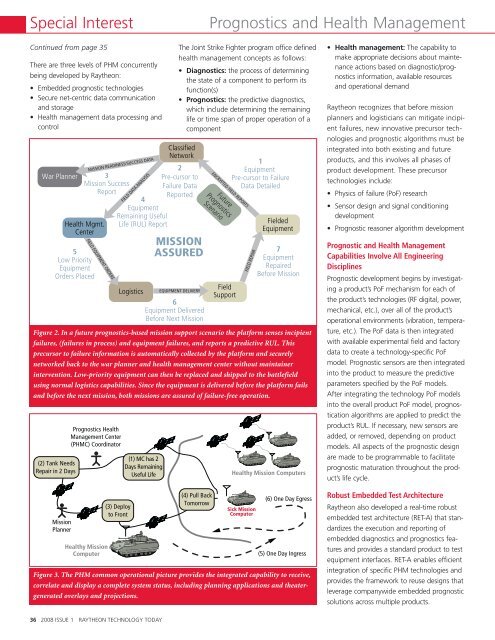Technology Today issue 1 2008 - Raytheon
Technology Today issue 1 2008 - Raytheon
Technology Today issue 1 2008 - Raytheon
You also want an ePaper? Increase the reach of your titles
YUMPU automatically turns print PDFs into web optimized ePapers that Google loves.
Special Interest<br />
Continued from page 35<br />
There are three levels of PHM concurrently<br />
being developed by <strong>Raytheon</strong>:<br />
Embedded prognostic technologies<br />
Secure net-centric data communication<br />
and storage<br />
Health management data processing and<br />
control<br />
War Planner<br />
Health Mgmt.<br />
Center<br />
5<br />
Low Priority<br />
Equipment<br />
Orders Placed<br />
MISSION READINESS/SUCCESS DATA<br />
3<br />
Mission Success<br />
Report<br />
FIELD EQUIPMENT ORDERS<br />
Logistics<br />
36 <strong>2008</strong> ISSUE 1 RAYTHEON TECHNOLOGY TODAY<br />
4<br />
FIELD DATA ANALYSIS<br />
Equipment<br />
Remaining Useful<br />
Life (RUL) Report<br />
The Joint Strike Fighter program office defined<br />
health management concepts as follows:<br />
Classified<br />
Network<br />
2<br />
Pre-cursor to<br />
Failure Data<br />
Reported<br />
MISSION<br />
ASSURED<br />
EQUIPMENT DELIVERY<br />
6<br />
Equipment Delivered<br />
Before Next Mission<br />
Diagnostics: the process of determining<br />
the state of a component to perform its<br />
function(s)<br />
Prognostics: the predictive diagnostics,<br />
which include determining the remaining<br />
life or time span of proper operation of a<br />
component<br />
ENCRYPTED FIELD REPORTS<br />
Future<br />
Prognostics<br />
Scenario<br />
Field<br />
Support<br />
1<br />
Equipment<br />
Pre-cursor to Failure<br />
Data Detailed<br />
Fielded<br />
Equipment<br />
7<br />
Equipment<br />
Repaired<br />
Before Mission<br />
Figure 2. In a future prognostics-based mission support scenario the platform senses incipient<br />
failures, (failures in process) and equipment failures, and reports a predictive RUL. This<br />
precursor to failure information is automatically collected by the platform and securely<br />
networked back to the war planner and health management center without maintainer<br />
intervention. Low-priority equipment can then be replaced and shipped to the battlefield<br />
using normal logistics capabilities. Since the equipment is delivered before the platform fails<br />
and before the next mission, both missions are assured of failure-free operation.<br />
(2) Tank Needs<br />
Repair in 2 Days<br />
Mission<br />
Planner<br />
Prognostics Health<br />
Management Center<br />
(PHMC) Coordinator<br />
Healthy Mission<br />
Computer<br />
(3) Deploy<br />
to Front<br />
(1) MC has 2<br />
Days Remaining<br />
Useful Life<br />
(4) Pull Back<br />
Tomorrow<br />
FIELD REPAIR<br />
Healthy Mission Computers<br />
Sick Mission<br />
Computer<br />
(6) One Day Egress<br />
(5) One Day Ingress<br />
Figure 3. The PHM common operational picture provides the integrated capability to receive,<br />
correlate and display a complete system status, including planning applications and theatergenerated<br />
overlays and projections.<br />
Prognostics and Health Management<br />
Health management: The capability to<br />
make appropriate decisions about maintenance<br />
actions based on diagnostic/prognostics<br />
information, available resources<br />
and operational demand<br />
<strong>Raytheon</strong> recognizes that before mission<br />
planners and logisticians can mitigate incipient<br />
failures, new innovative precursor technologies<br />
and prognostic algorithms must be<br />
integrated into both existing and future<br />
products, and this involves all phases of<br />
product development. These precursor<br />
technologies include:<br />
Physics of failure (PoF) research<br />
Sensor design and signal conditioning<br />
development<br />
Prognostic reasoner algorithm development<br />
Prognostic and Health Management<br />
Capabilities Involve All Engineering<br />
Disciplines<br />
Prognostic development begins by investigating<br />
a product’s PoF mechanism for each of<br />
the product’s technologies (RF digital, power,<br />
mechanical, etc.), over all of the product’s<br />
operational environments (vibration, temperature,<br />
etc.). The PoF data is then integrated<br />
with available experimental field and factory<br />
data to create a technology-specific PoF<br />
model. Prognostic sensors are then integrated<br />
into the product to measure the predictive<br />
parameters specified by the PoF models.<br />
After integrating the technology PoF models<br />
into the overall product PoF model, prognostication<br />
algorithms are applied to predict the<br />
product’s RUL. If necessary, new sensors are<br />
added, or removed, depending on product<br />
models. All aspects of the prognostic design<br />
are made to be programmable to facilitate<br />
prognostic maturation throughout the product’s<br />
life cycle.<br />
Robust Embedded Test Architecture<br />
<strong>Raytheon</strong> also developed a real-time robust<br />
embedded test architecture (RET-A) that standardizes<br />
the execution and reporting of<br />
embedded diagnostics and prognostics features<br />
and provides a standard product to test<br />
equipment interfaces. RET-A enables efficient<br />
integration of specific PHM technologies and<br />
provides the framework to reuse designs that<br />
leverage companywide embedded prognostic<br />
solutions across multiple products.

















